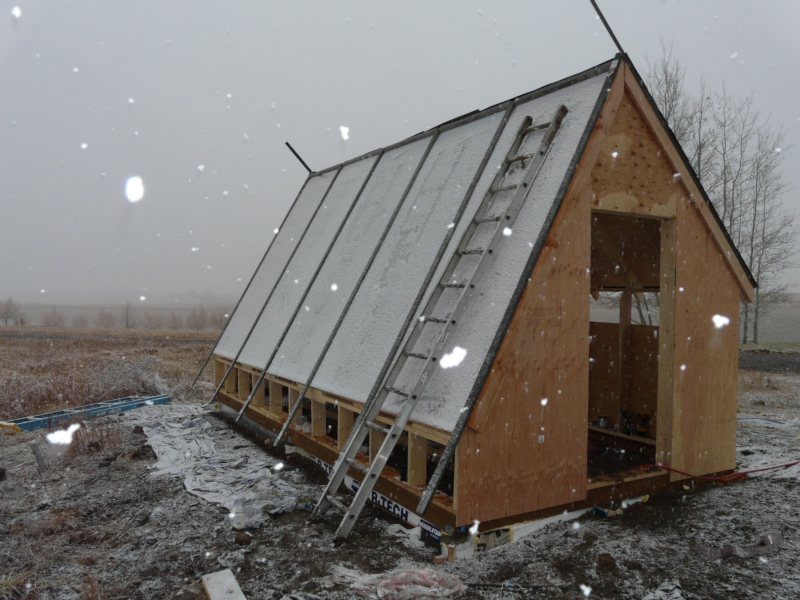
Search
The Renewable Energy site for Do-It-Yourselfers
Low Thermal Mass Attached Sunspaces
for Home Solar Heating -- A Performance Test
|
This section covers some tests done on a low thermal mass sunspace
that uses a design optimized to produce solar heat for space heating a
home that is connected to the sunspace.
We look at: how efficient it is in producing heat for spaced heating
compared to conventional solar collectors, the effect of some design
variations on heat output, a survey of the temperatures in various parts
of the sunspace, and what things can be done to maximize the use of the
sunspace for a variety of purposes (producing heat, pleasant place to
spend time, doing laundry, ...).

I think that attached sunspaces are 1) underused as a way to provide
both solar heating and very usable space, and 2) often not very well
optimized to do the heat production job well. If you have a sunspace,
I'd very much like to hear what your experience has been (good or bad),
and what your ideas for improvements are. |
|
I'm doing this work in what will become our all season greenhouse. This
results in some things that are not quite right:
- The greenhouse is freestanding and not attached to a house. Given
that the back wall is well insulated, I don't think that this makes much
difference in the results.
- The heated air is just blown out into the great outdoors through those
odd looking ducts above the door. The sunspace is too far away from
the house to make duct the hot air to it. I don't think this makes any
difference in the results.
- The intake air is taken from outside, so its much colder than it would
be in an attached sunspace where it would be (say) 65F air from the house.
This does effect the results. The consequences of the cold inlet air
are explained in the performance section.
- All of the things like insulation levels, thermal mass, wall colors,
interior configuration were set up to optimize sunspace performance, and
will be changed when its converted into its greenhouse role.
Bottom line is that I think that using the greenhouse as a sunspace simulator
gives good results, and there is so little actual measured performance data out
there on sunspace performance that its quite useful.
Page Index
- Configurations
cover construction
- Performance Tests (have a brief summary of the tests on
this page with separate pages for the details)
- What its like to live in
- Cost
- Conclusions
- Comments
Test Sunspace Description
The sunspace performance tests were actually done in our new all-season
greenhouse. I've had a long term interest in seeing how well an attached,
low thermal mass sunspace actually performs compared to (say) active solar
collectors, and the greenhouse has a lot of the same features, so we decided to
use it to do some sunspace performance tests before it becomes a greenhouse.
The main features include:
- A 200 sqft glazed area that is oriented at a steep tilt angle for
maximum winter solar gain. The glazing is double wall polycarbonate
for better winter performance (lower glazing heat loss).
The glazed area is just about equal to the total floor area.
- Surfaces that do not receive much winter sun are not glazed as
they might be in a 3 season greenhouse. This is to reduce the heat
loss through the glazing, which is high.
- The sunspace has very low thermal mass so that the bulk of the incident
solar heat is carried off to the attached house, and very little is stored
in the sunspace mass.
For example, If the fan that removes heat from the sunspace is turned off,
the sunspace increases in temperature at a rate of about 10F per minute.
- All non-glazed surfaces are well insulated. The North, East and
West walls, the North ceiling, and the floor are all insulted. Walls
and ceiling are insulated to R27, while the floor is insulated to about R6.
- The sunspace is well sealed against air infiltration.
- All inside surfaces that see the sun are painted dark to absorb the sun.
These surfaces are also low mass, insulating surfaces that heat up very
quickly when the sun is on them. This results in rapid heating of the
air next to the surface The heated air then rises up to the peak area
where the fan and ducting move it to the house.
The end result is a space that heats up very quickly when the sun gets on
it-- it is ready to start making heat for the attached house as soon as the sun
is on it.
At the end of the day, when the sun goes off the sunspace it very quickly
cools to the outdoor temperature, because it has no stored heat.
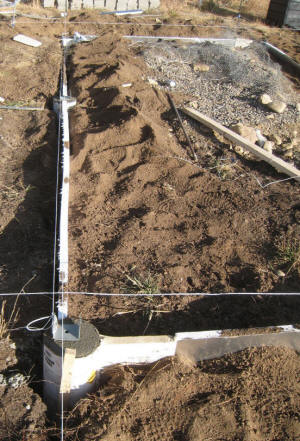
Built on footing posts with 1.5 inch
vertical Styrofoam insulation extending
2 ft down. |
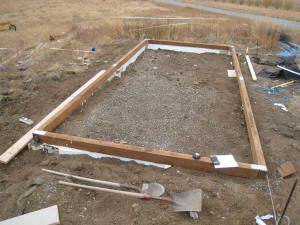
Built on treated lumber sill plates. |
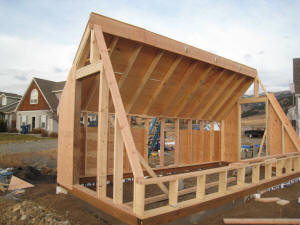
Framed with 2 by 6 lumber 24 OC.
|
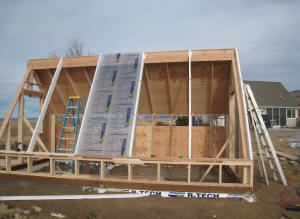
Glazed with 10 mm thick twinwall
polycarbonate glazing in 4 by 10 ft sheet.
200 sqft of glazing total. |
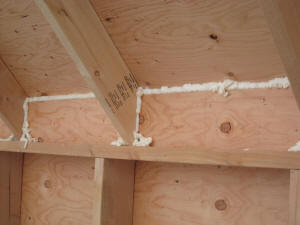
Pretty carefully sealed. |
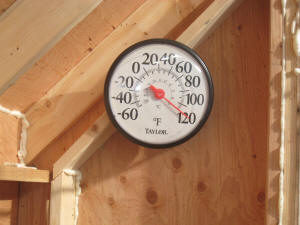
Gets pretty warm even before
insulation was installed. |
Tested Configurations
The sunspace was tested in two basic configurations.
Configuration 1: Non-Optimized
This test was done earlier in the construction before
some of the features above were incorporated. The glazing and shell were
in place, but the floor was bare (heat absorbing) dirt, and the walls and
ceilings were not insulated.
Interior surfaces were not painted a dark color.
The idea was to see how much difference it degrades the
performance if not all of the features listed above are included.
<show pictures of config 1>
Configuration 2: Optimized -- vertical screen
This configuration included all of the features listed
above. The walls, ceiling and floor were insulated and nearly all interior
surfaces were painted dark.
In addition, a screen of dark weed fabric was hung
vertically in the space. The fabric was suspended from near the peak and
ran vertically down to the floor, and then extended south toward the glazing
along the floor.
The idea is to see if this vertical screen is more
efficient in getting the heat up to the peak area. The screen was also
helpful in evaluating whether some form of screen is desirable to increase the
comfort for people using the sunspace to (say) read or have a cup of coffee.
< pictures>
Configuration 3: Optimized -- screen on floor
This configuration is nearly the same as configuration 2,
except that the dark weed fabric was just distributed evenly over the full
floor. So, for this configuration, the sun could shine onto the
north wall and north roof.
< picture>
The results of the testing for each of these configurations are given below.
Performance Tests
This section give the details on three days of testing covering the three
configurations listed above.
Each test includes the following:
- Regular and thermal camera images
- Logged temperatures and sun levels for the test
- A sampling of temperatures around the sunspace
- Estimates of collector efficiency
<give enough of a teaser on each test to encourage people to go to that page
< do optimized tests first
Configuration 1: Optimized Sunspace -- Vertical Screen
Configuration 1: Optimized Sunspace -- Floor Screen
Configuration 1: Non-Optimized Sunspace
How the Performance Measurements Were Made
Getting good performance data on solar heating collectors is challenging, and
air heating collectors are even more challenging. Its right to be a bit
skeptical about performance numbers you see around the internet. So, here
is a rundown on the instrumentation I used.
Sun -- Sun intensity was measured with an Apogee
pyranometer that was mounted to the glazing frame and was perpendicular to the
plane of the glazing.

In this position, it directly measures the sun intensity on the glazing.
Temperatures -- I used
Onset Computer loggers with thermistor sensors to measure the temperatures
used for performance calculations. These sensors specifications call for
plus/minus 0.25 C accuracy. A a check, I generally put all the sensors
together in the same location at the start of the test and make sure they read
close to the same value.
Areas -- Glazing area was measured with a tape, and the
frames were included (not just net glazed area) -- this is in the SRCC
style.
Flow Rates -- In air collector testing, getting good
estimates for flow velocity is the most challenging measurement. I went
through several iterations getting to an arrangement that I feel is giving
decently accurate velocities. The final arrangement includes an about 11
ft long straight length of 10 inch duct on the exit of each of the two fans (13
diameters of straight duct before the measurement station). This lets the
turbulent flow of the fan mix and settle down after leaving the fan.
A 2 ft long flow straightener is used to take most of the swirl out of the flow.
Before the flow straightener was installed, the swirl velocity was about 400 fpm
and the velocity in the center of the duct was significantly lower than the
velocities around the periphery. With the flow straighteners, the velocity
profile is as expected with higher center velocity, and consistent velocities
around the periphery.
I take the velocity measurements with a new
Kestrel 1000 turbine style anemometer. The Kestrels are high quality
instruments that all receive an individual factory calibration before going
out-- they are certified to be within plus/minus 1.66% for the velocity range I
use.
I take one reading in the center of the duct, and 4 readings around the
periphery (up, down, North, and south). The 5 readings are simply averaged
to get an estimate of the average flow. I take these readings several
times during the day -- they tend to be quite consistent. Typical readings
would be 740 fpm center. Readings around the periphery vary from about 530
fpm to 630 fpm, but the readings at each peripheral point are quite consistent
from one reading to the next. The swirl component of the velocity is less
than 100 fpm.

The afterburner on the new sunspace propulsion system.
I'm expecting it to do Mach 0.86 at 32,000 ft.
It is (maybe) interesting to note that before the flow straighteners were
installed, and with a lot of swirl velocity, taking the 5 readings in the same
places as mentioned above -- each individual reading was markedly different than
the after flow straightener readings, but the average of the 5 readings was
close.
I may further check these readings with a Pitot tube survey, but the
velocities are down in the range that are difficult to measure accurately with a
Pitot tube (600 ft/min). Past experience leads me to believe that the
Kestrel is probably the best way to go.
Air Density -- I use a density of air of 0.061 lb/cf -- this
correction from the sea level standard conditions of 0.075 lb/cf accounts for
our altitude of 5000 ft. and 80F air temperature. Based on
this calculator.
What is it Like to Live In?
I spent the better part of several days in the sunspace during the testing,
so these are some quick impressions of how it is to be in while its in the
process of gathering heat for the house.
There were a lot of times when the sunspace was quite pleasant to be in.
But, there were times near midday when the glare from the sun and reflection off
the snowfield were a bit uncomfortable for me (this may be a matter of personal
taste). I think that some form of shade cloth like screen that runs
parallel to the glazing and can be deployed to filter the sun, or pushed to the
side to let in all the available sun would be good. It would allow you to
quickly adapt to full sun, part sun and light overcast conditions and to
personal tastes.
Even though I would call the Grainger fans I used relatively quiet, the fan
noise would be objectionable for (say) reading the paper or having a
conversation or just having a cup of coffee. Using fans that
are very quiet and/or getting them into locations that noise shield them from
the sunspace is important.
As a place to hang clothes for drying, it would seem very good. The air
is warm and is moving, which should reduce drying time, and it could be setup so
that the sun shines directly on the clothing to further reduce drying time.
One observation is that it does not take very much sun to warm the sunspace
up to where its comfortable to be in. Even in light overcast conditions
where it does not generate enough heat to do much house heating, it can be quite
comfortable to be in.
Another thing that is no surprise is that that when sunset rolls around, the
temperature in the sunspace falls like a rock. It very quickly becomes a
very chilly place.
Cost
This is a very rough idea what an attached sunspace modeled after the
freestanding greenhouse in the pictures above might cost. Its based on
what I paid for the materials for the GH, but adjusted down in places because
the sunspace would not have a north wall.
It includes what you see in the pictures -- nothing fancy.
|
Item |
Cost |
| Glazing |
$414.00 |
| Foundation
Supplies |
$285.00 |
| Framing and
plywood |
$420.00 |
| Shingled
roof |
$150.00 |
| Insulation |
$150.00 |
| Door |
$157.00 |
| Fans |
$180.00 |
| ductwork |
$77.00 |
| Controls |
$60.00 |
| Paint,
Great Stuff, … |
$100.00 |
| |
|
| Total |
$1,993.00 |
Bear in mind that costs of low thermal mass sunspaces can vary over a huge
range. There are a couple of examples of
dirt cheap ones that can be built for $25 ish, all the way up to ones
that cost a couple hundred per sqft. They all heat well -- the cost
is more a matter of the look and feel that you want to achieve.
Just as a very rough idea how other solar heating options might compare:
- 200 sqft worth of commercial air heating panels (you
install) -- roughly $10,000 (kind of mind boggling)
- 200 sqft of DIY air heating panels with fans, ducts,
... $1500?
- 200 sqft of DIY simple thermosyphon air heating
collector like
this one $450
Of course, the sunspace comes with all sorts of functionality beyond the
solar heating, whereas the rest of the options just do heating.
Conclusions
Comments



